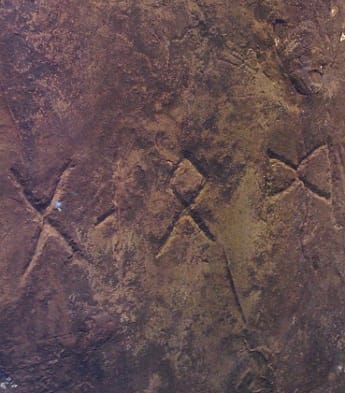What is the Heavener Runestone
The Heavener Runestone is a large stone located in the Heavener Runestone State Park
in Heavener Oklahoma that has runes (ancient Viking letters) carved on it.
There are many people who believe the inscriptions on the rock were made by an ancient
Norse explorer who incredibly traveled to Oklahoma centuries before Columbus traveled to
America. Most experts do not believe the carvings on the stone are that old. If indeed
genuine, it would mean the ancient Norse explorers traveled much further into North America
than previously believed.
Click here for a great selection of Amazon.com
books about the Vikings.
On this page we provide information on where the runestone is, how it was discovered, and why there is so much controversy over whether it is real or not.
How the was Heavener Runestone discovered
According to local legend the runestone was discovered by an Indian hunting party in the 1830's. In the late 1800's there are several documented viewings of the runestone. In the early 1870's, according to his son, a man named Wilson King saw the stone. In 1898 a man named Luther Capps saw it. The people of Heavener called the strange rock the "Indian Rock". It wasn't until around 1923, when a man named Carl F. Kemmerer sent a copy of the symbols to the Smithsonian Institution, that the inscriptions were identified as runic. In 1928 Mr. Kemmerer took a little girl named Gloria Stewart to see the runestone. She would later spend many years researching it. She claimed it was authentic and renamed it the Heavener Runestone.
Description of the Heavener Runestone
The runestone is approximately twelve feet high, ten feet wide, and sixteen inches thick and has eight runes carved on its face towards the top. It is located on Poteau Mountain part of the Ouachita Mountains that stretch across the border of Arkansas and Oklahoma. It stands in what is now the Heavener Runestone State Park. A structure has been constructed around it for protection.
The eight runes carved on its face are in a straight line and six to nine inches in height, and one-fourth to three sixteenths of an inch in depth.
Not only is the authenticity of the stone debated but also the meaning of the inscriptions is questioned. Some interpretations of the inscriptions indicate the runestone may have been used as a property marker because it bears the name "G. Nomedal", Nomedal is a Norwegian family name. Others interpret it to read "Glomesdal" or "Valley of Glome"; and believe Glome is the name of an ancient Viking explorer. Another interpretation of the inscription is "Gnonesdal" or "Valley of the Gnomes". Gnomes are tiny mythical creatures that the ancient Norse believe existed. The beautiful ravine where the Heavener Runestone sits does in many ways resemble the type of place the ancient Vikings believed Gnomes lived.
Heavener Runestone - Conclusion
Hoax or ancient relic from the past? The question remains unanswered. Most Rune experts believe the inscriptions were made sometime in the 19th or 20th century. They point out that the Rune alphabet used on the stone, called the Elder Futhark, had become obsolete well before the Vikings ever even traveled to Greenland and certainly well before the earliest known voyage of the Vikings to North America. They go on to point out that only six of the eight characters on the runestone are correct symbols in the Elder Futhark. These facts along with the fact that no other verifiable Norse artifacts have ever been found in the area makes for a strong case that the inscriptions were not made by an ancient Viking explorer.
People who believe the runestone to be an authentic ancient relic point out that two other smaller stones have been found in the same area with runic inscriptions. They also ask if it wasn't a Viking that inscribed the letters on the stone then who else. With sightings going back to the early 1800's who would have had the knowledge of the runic alphabet and what reason would they have had to leave the inscription on the rock? As far as the misspellings on the rock a man named Richard Nielsen had a theory.
He believed the last symbol, which is misspelled (not in the Elder Futhark), was accidentally reversed, by the Viking inscriber. As for the other symbol not in the Elder Futhark, the second symbol, he believes the Viking explorer substituted a letter from the Gothic alphabet. If these mistakes were true then the stone would read "GLOME DAL" (translation "Valley of Glome").
Perhaps in time the mystery of the Heavener Runestone will be revealed. Maybe new discoveries will be made that will either dismiss it as a hoax or prove the ancient Vikings were even more amazing explorers than currently believed.
